Fracture Properties of Nitrogen–Slick Water Composite Fracturing in Coal Reservoir
Abstract
1. Introduction
2. Geological Setting and Composite Fracturing Experiments
2.1. Geologic Setting
2.2. Nitrogen–Slick Water Composite Fracturing
2.3. Micro-Seismic Monitoring
3. Methodology and Result
3.1. Methodology
3.1.1. Ratio of Fracture Ellipsoid
3.1.2. Micro-Seismic Focal Mechanism
3.1.3. Seismological Source Parameters
3.2. Results
3.2.1. Fracture Morphology
3.2.2. Mechanical Properties of Fractures
3.2.3. b-Value
3.2.4. Stress Drop
4. Discussion
4.1. Mechanism of Gas–Water Composite Fracturing
4.2. Mechanism under Which Permeability Increases during Gas–Water Composite Fracturing
5. Conclusions
- (1)
- The NF, CF, and HF stages were characterized by different mechanical properties of the produced fractures. The proportion of tensile fractures decreased from 33.5% to 30.3%, with an increased proportion in the fracturing fluid, whereas the proportion of strike-slip fractures increased from 50.4% to 54.6%.
- (2)
- The stress drop and b-value in the NF stages exceeded those in the HF stages, with an average of twice as large, which represented higher stress disturbance. This result further supports the assertion of a more significant number of tensile fractures being formed in the NF stage.
- (3)
- The theoretical basis for the formation of a more significant number of tensile fractures through gas fracturing and the higher permeability of NF was proposed based on the influence of gas compressibility and pore pressure on coal fractures.
Author Contributions
Funding
Data Availability Statement
Conflicts of Interest
References
- Jeffrey, R. Hydraulic Fracturing for Coal Seam Gas (CSG) Stimulation in NSW; Report EP122949; CSIRO Earth Science and Resource Engineering: Canberra, ACT, Australia, 2012. [Google Scholar]
- Lei, Q.; Xu, Y.; Cai, B.; Guan, B.; Wang, X.; Bi, G.; Li, H.; Li, S.; Ding, B.; Fu, F.; et al. Progress and prospects of horizontal well fracturing technology for shale oil and gas reservoirs. Pet. Explor. Dev. 2022, 49, 191–199. [Google Scholar] [CrossRef]
- Liang, W.; Yan, J.; Zhang, B.; Hou, D. Review on coal bed methane recovery theory and technology: Recent progress and perspectives. Energy Fuels. 2021, 35, 4633–4643. [Google Scholar] [CrossRef]
- Hu, Q.; Liu, L.; Li, Q.; Wu, Y.; Wang, X.; Jiang, Z.; Wu, X. Experimental investigation on crack competitive extension during hydraulic fracturing in coal measures strata. Fuel 2020, 265, 117003. [Google Scholar] [CrossRef]
- Mou, P.; Pan, J.; Wang, K.; Wei, J.; Yang, Y.; Wang, X. Influences of hydraulic fracturing on microfractures of high-rank coal under different in-situ stress conditions. Fuel 2021, 287, 119566. [Google Scholar] [CrossRef]
- Detournay, E. Slickwater hydraulic fracturing of shales. J. Fluid Mech. 2020, 886, F1. [Google Scholar] [CrossRef]
- Su, X.; Li, F.; Su, L.; Wang, Q. The experimental study on integrated hydraulic fracturing of coal measures gas reservoirs. Fuel 2020, 270, 117527. [Google Scholar] [CrossRef]
- Zhao, J.; Liu, P.; Li, J.; Chen, Z.; Li, Y.; Li, F. Fracture propagation induced by hydraulic fracturing using microseismic monitoring technology: Field test in CBM wells in Zhengzhuang region, Southern Qinshui Basin, China. Front. Earth Sci. 2023, 11, 1130280. [Google Scholar] [CrossRef]
- Scott, M.P.; Johnson, J.R.; Spilsbury-Schakel, J.; Garnett, A. Technology review of the Northern Bowen and Galilee basins. APPEA J. 2023, 63, 90–109. [Google Scholar] [CrossRef]
- McCarthy, C.; Garcia, M. Hydraulic Fracturing Placement Issues on Horizontal Wells in the Mancos Shale, San Juan Basin: Case Study of Possible Causes, Solutions, and Results. In Proceedings of the SPE Rocky Mountain Petroleum Technology Conference/Low-Permeability Reservoirs Symposium 2016, Denver, CO, USA, 14–16 April 2016; p. SPE-180252. [Google Scholar]
- Freyman, M. Hydraulic Fracturing & Water Stress: Water Demand by the Numbers; Ceres: Boston, MA, USA, 2014; p. 85. [Google Scholar]
- Chen, H.; Carter, K.E. Water usage for natural gas production through hydraulic fracturing in the United States from 2008 to 2014. J. Environ. Manag. 2016, 170, 152–159. [Google Scholar] [CrossRef]
- Tian, L.; Cao, Y.; Chai, X.; Liu, T.; Feng, P.; Feng, H.; Rodvelt, G. Best practices for the determination of low-pressure/permeability coalbed methane reservoirs, Yuwu Coal Mine, Luan mining area, China. Fuel 2015, 160, 100–107. [Google Scholar] [CrossRef]
- Cao, Y.; Zhang, J.; Zhai, H.; Fu, G.; Tian, L.; Liu, S. CO2 gas fracturing: A novel reservoir stimulation technology in low permeability gassy coal seams. Fuel 2017, 203, 197–207. [Google Scholar] [CrossRef]
- Cao, Y.; Shi, B.; Tian, L.; LI, F.; CAO, Y.; Dong, S.; Zhou, D. Development and application of dense multi-cluster fracturing in horizontal wells for low permeability and low-pressure coal reservoir. J. China Coal Soc. 2020, 45, 3512–3521. [Google Scholar]
- Longinos, S.N.; Dillinger, A.; Wang, L.; Hazlett, R. Uniaxial compressive strength (UCS) and SEM study of liquid nitrogen for waterless hydraulic fracturing in coalbed methane reservoirs of Karaganda Basin in Kazakhstan. Gas Sci. Eng. 2023, 115, 204998. [Google Scholar] [CrossRef]
- Longinos, S.N.; Abbas, A.H.; Bolatov, A.; Skrzypacz, P.; Hazlett, R. Application of Image Processing in Evaluation of Hydraulic Fracturing with Liquid Nitrogen: A Case Study of Coal Samples from Karaganda Basin. Appl. Sci. 2023, 13, 7861. [Google Scholar] [CrossRef]
- Longinos, S.N.; Serik, A.; Bayramov, E.; Junussov, M.; Begaliyev, D.; Hazlett, R. Laboratory Study of Liquid Nitrogen Cryo-Fracturing as an Environmentally Friendly Approach for Coalbed Methane (CBM) Reservoirs. Energies 2024, 17, 2359. [Google Scholar] [CrossRef]
- Huang, Z.; Zhang, S.; Yang, R.; Wu, X.; Li, R.; Zhang, H.; Hung, P. A review of liquid nitrogen fracturing technology. Fuel 2020, 266, 117040. [Google Scholar] [CrossRef]
- Qin, L.; Zhang, X.; Zhai, C.; Lin, H.; Lin, S.; Wang, P.; Li, S. Advances in liquid nitrogen fracturing for unconventional oil and gas development: A review. Energy Fuels 2022, 36, 2971–2992. [Google Scholar] [CrossRef]
- Cao, Y.; Shi, F.; Zhou, D.; Wu, H.; Liu, T.; Tian, L. Study and application of stimulation technology for low production CBM well through high pressure N2 Injection-soak. J. China Coal Soc. 2019, 44, 2556–2565. [Google Scholar]
- Ni, X. Study on improving coal-bed gas recovery rate by hydraulic fracturing and nitrogen injection of borehole. Min. Saf. Environ. Prot. 2012, 39, 1–5. [Google Scholar]
- Shi, B. Study on the Permeability Enhancement Mechanism of Nitrogen-Hydraulic Composite Fracturing in Coal Reservoirs; Henan Polytechnic University: Jiaozuo, China, 2022. [Google Scholar]
- Zhang, L.; Chen, S.; Zhang, C.; Fang, X.; Li, S. The characterization of bituminous coal microstructure and permeability by liquid nitrogen fracturing based on μCT technology. Fuel 2020, 262, 116635. [Google Scholar] [CrossRef]
- Xue, Y.; Liu, J.; Ranjith, P.G.; Gao, F.; Xie, H.; Wang, J. Changes in microstructure and mechanical properties of low-permeability coal induced by pulsating nitrogen fatigue fracturing tests. Rock Mech. Rock Eng. 2022, 55, 7469–7488. [Google Scholar] [CrossRef]
- Qin, L.; Ma, C.; Li, S.; Lin, H.; Wang, P.; Long, H.; Yan, D. Mechanical damage mechanism of frozen coal subjected to liquid nitrogen freezing. Fuel 2022, 309, 122124. [Google Scholar] [CrossRef]
- Liang, X.; Hou, P.; Xue, Y.; Yang, X.; Gao, F.; Liu, J. A fractal perspective on fracture initiation and propagation of reservoir rocks under water and nitrogen fracturing. Fractals 2021, 29, 2150189. [Google Scholar] [CrossRef]
- Detournay, E. Mechanics of hydraulic fractures. Annu. Rev. Fluid Mech. 2016, 48, 311–339. [Google Scholar] [CrossRef]
- Cao, T.; Yang, Z.; Qin, Y.; Yan, Z.; Chen, Z.; Li, C. Characteristics of modern geostress and removability of No. 15 coal reservoir, Yangquan mining area, China. Nat. Resour. Res. 2021, 30, 2211–2223. [Google Scholar] [CrossRef]
- Jia, Y.; Xie, X.; Lu, A. Geological and gas-content features of coalbed methane system in Qinshui Basin, Shanxi. Appl. Mech. Mater. 2012, 170, 1187–1191. [Google Scholar] [CrossRef]
- Liu, B.; Chang, S.; Zhang, S.; Li, Y.; Yang, Z.; Liu, Z.; Chen, Q. Seismic-Geological Integrated Study on Sedimentary Evolution and Peat Accumulation Regularity of the Shanxi Formation in Xinjing Mining Area, Qinshui Basin. Energies 2022, 15, 1851. [Google Scholar] [CrossRef]
- Li, L.; Jiang, B.; Li, M.; Liu, J.; Ren, J. Tectonic characteristics and evolution analysis of Xinjing coal mine in Yangquan. Coal Technol. 2014, 33, 84–86. [Google Scholar]
- Chang, S.; Liu, J.; Zhang, S.; Shi, X.; Liu, Z.; Yang, Z. Geological control of tectonic coal distribution and its integrated seismic geological prediction method: A case study of No.3 coal seam in Xinjing mine, Yangquan, Qinshui Basin. Geophys. Prospect. Pet. 2023, 62, 43–55. [Google Scholar]
- Longinos, S.N.; Wang, L.; Hazlett, R. Advances in cryogenic fracturing of coalbed methane reservoirs with LN2. Energies 2022, 15, 9464. [Google Scholar] [CrossRef]
- Longinos, S.N.; Serik, A.; Zhang, D.; Wang, L.; Hazlett, R. Experimental Evaluation of Liquid Nitrogen Fracturing on the Coal Rocks in Karaganda Basin, Kazakhstan. Arab. J. Sci. Eng. 2023, 48, 16623–16638. [Google Scholar] [CrossRef]
- Wang, Q.; Su, X.; Feng, Y.; Wang, H.; Song, J. Experimental study of gas-water two-phase flow patterns in fracture: Implication for enhancing coalbed methane production. J. Pet. Sci. Eng. 2021, 207, 109168. [Google Scholar] [CrossRef]
- Li, X.; Cheng, Y.; Tao, W.; Sarulicaoketi, S.; Ji, X.; Yin, C. Experimental Study on Enhanced Oil Recovery by Nitrogen-Water Alternative Injection in Reservoir with Natural Fractures. Geofluids 2021, 2021, 1–9. [Google Scholar] [CrossRef]
- Feng, Y.; Haugen, K.; Firoozabadi, A. Phase-field simulation of hydraulic fracturing by CO2, water and nitrogen in 2D and comparison with laboratory data. J. Geophys. Res. Solid Earth 2021, 126, e2021JB022509. [Google Scholar] [CrossRef]
- Hou, P. Fracturing Mechanism and Permeability Enhancements Effect Induced by Gas Fracturing in Low Permeability Reservoir Rocks; China University of Mining & Technology: Beijing, China, 2018. [Google Scholar]
- Xu, D. Analysis on production increasing mechanism and crack extension law of compound fracturing. Petrochem. Ind. Appl. 2015, 34, 17–19. [Google Scholar]
- Sun, Q. Research and Application of the Technology of Liquid Powder-High Energy Gas and Hydraulic Composite Fracturing. Sino-Glob. Energy 2010, 15, 60–62. [Google Scholar]
- Li, L.; Tan, J.; Wood, D.A.; Zhao, Z.; Becker, D.; Lyu, Q.; Chen, H. A review of the current status of induced seismicity monitoring for hydraulic fracturing in unconventional tight oil and gas reservoirs. Fuel 2019, 242, 195–210. [Google Scholar] [CrossRef]
- Tian, L.; Cao, Y.; Liu, S.; Shi, B.; Liu, J.; Elsworth, D. Coalbed methane reservoir fracture evaluation through the novel passive microseismic survey and its implications on permeable and gas production. J. Nat. Gas Sci. Eng. 2020, 76, 103181. [Google Scholar] [CrossRef]
- Schultz, R.; Skoumal, R.J.; Brudzinski, M.R.; Eaton, D.; Baptie, B.; Ellsworth, W. Hydraulic fracturing-induced seismicity. Rev. Geophys. 2020, 58, e2019RG000695. [Google Scholar] [CrossRef]
- Li, L.; Tan, J.; Tan, Y.; Pan, X.; Zhao, Z. Microseismic analysis to aid gas reservoir characterization. In Sustainable Geoscience for Natural Gas Subsurface Systems; Elsevier: Amsterdam, The Netherlands, 2022; pp. 219–242. [Google Scholar]
- Atkinson, G.M.; Eaton, D.W.; Igonin, N. Developments in understanding seismicity triggered by hydraulic fracturing. Nat. Rev. Earth Environ. 2020, 1, 264–277. [Google Scholar] [CrossRef]
- Wessels, S.A.; De La Peña, A.; Kratz, M.; Williams-Stroud, S.; Jbeili, T. Identifying faults and fractures in unconventional reservoirs through microseismic monitoring. First Break 2011, 29, 99–104. [Google Scholar] [CrossRef]
- Tian, L.; Li, Z.; Cao, Y.; Liu, S.; Song, Y. In situ stress distribution and variation monitored by microseismic tracking on a fractured horizontal well: A case study from the Qinshui basin. ACS Omega 2022, 7, 14363–14370. [Google Scholar] [CrossRef]
- Mishali, M.; Eldar, Y.C. Sub-nyquist sampling. IEEE Signal Process. Mag. 2011, 28, 98–124. [Google Scholar] [CrossRef]
- Romanov, E.; Ordentlich, O. Above the Nyquist rate, modulo folding does not hurt. IEEE Signal Process. Lett. 2019, 26, 1167–1171. [Google Scholar] [CrossRef]
- Xiong, Q.; Hampton, J.C. Semi-Empirical Error Ellipsoid Clustering for Identifying the Second-Order Structural Features from a Laboratory AE Source Location Cloud: Method, Validation, and Application to a Hydraulic Fracturing Test. Earth Space Sci. 2022, 9, e2022EA002349. [Google Scholar] [CrossRef]
- Liu, J. A Method for Analyzing the Source Mechanism Using Microseismic. China Patent CN103076634B, 8 July 2015. [Google Scholar]
- El-Isa, Z.H.; Eaton, D.W. Spatiotemporal variations in the b-value of earthquake magnitude–frequency distributions: Classification and causes. Tectonophysics 2014, 615, 1–11. [Google Scholar] [CrossRef]
- Li, B.; Ding, Q.; Xu, N.; Dai, F.; Xu, Y.; Qu, H.L. Characteristics of microseismic b-value associated with rock mass large deformation in underground powerhouse caverns at different stress levels. J. Cent. South Univ. 2022, 29, 693–711. [Google Scholar] [CrossRef]
- Feng, R.; Luo, H.; Chen, Z.; Zhang, F. Integrated microseismic and geomechanical analysis of hydraulic fracturing induced fault reactivation: A case study in Sichuan Basin, Southwest China. Geomech. Geophys. Geo-Energy Geo-Resour. 2023, 9, 48. [Google Scholar] [CrossRef]
- Arroyo-Solórzano, M.; Linkimer, L. Spatial variability of the b-value and seismic potential in Costa Rica. Tectonophysics 2021, 814, 228951. [Google Scholar] [CrossRef]
- Brune, J.N. Tectonic stress and the spectra of seismic shear waves from earthquake. J. Geophys. Res. 1970, 75, 4997–5009. [Google Scholar] [CrossRef]
- Xu, N.; Dai, F.; Zhou, Z.; Sha, C.; Tang, C. Study of characteristics of b value for microseismic events in high rock slope. Chin. J. Rock Mech. Eng. 2014, 33, 3368–3374. [Google Scholar]
- Hillis, R.R. Coupled changes in pore pressure and stress in oil fields and sedimentary basins. Pet. Geosci. 2001, 7, 419–425. [Google Scholar] [CrossRef]
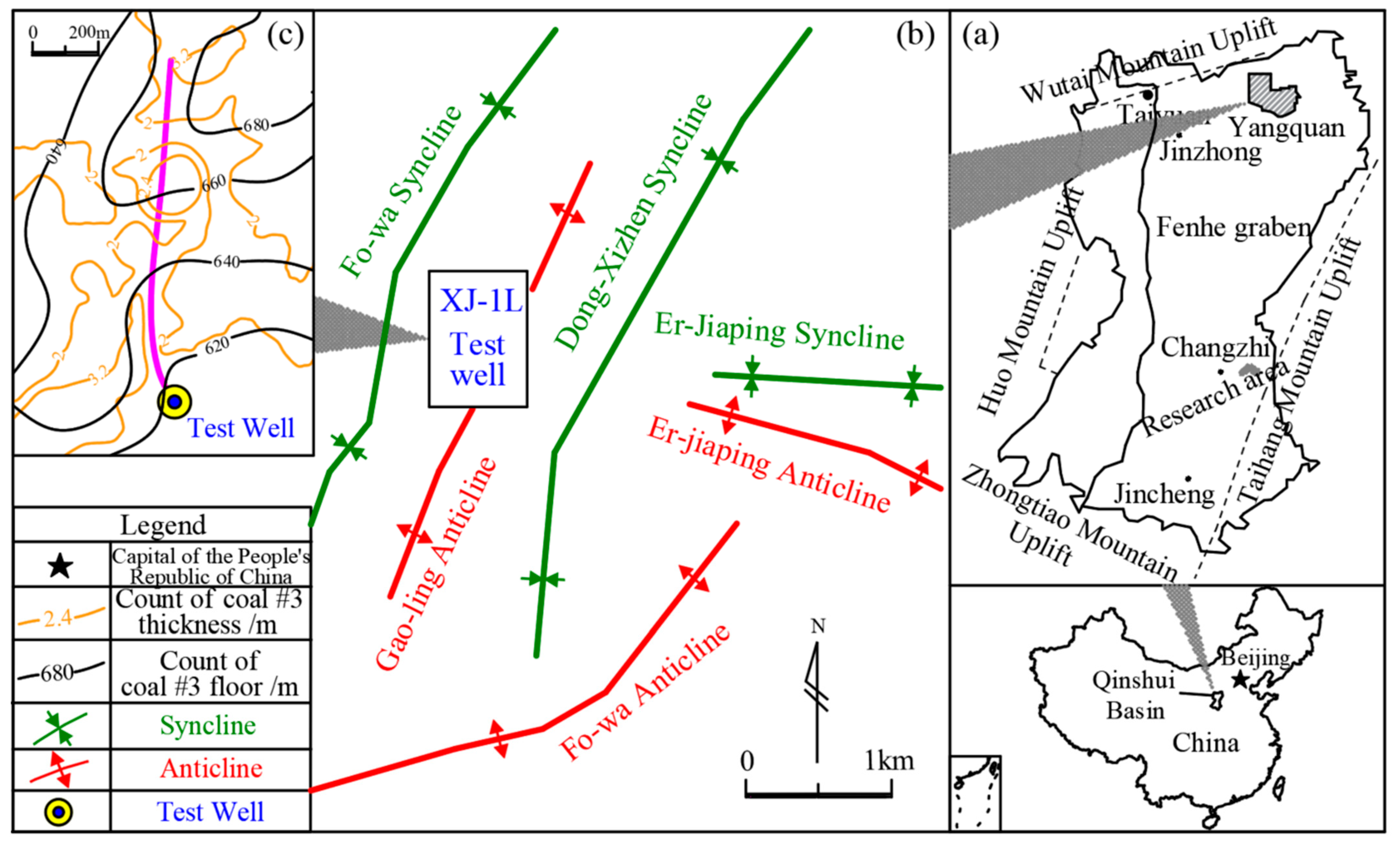


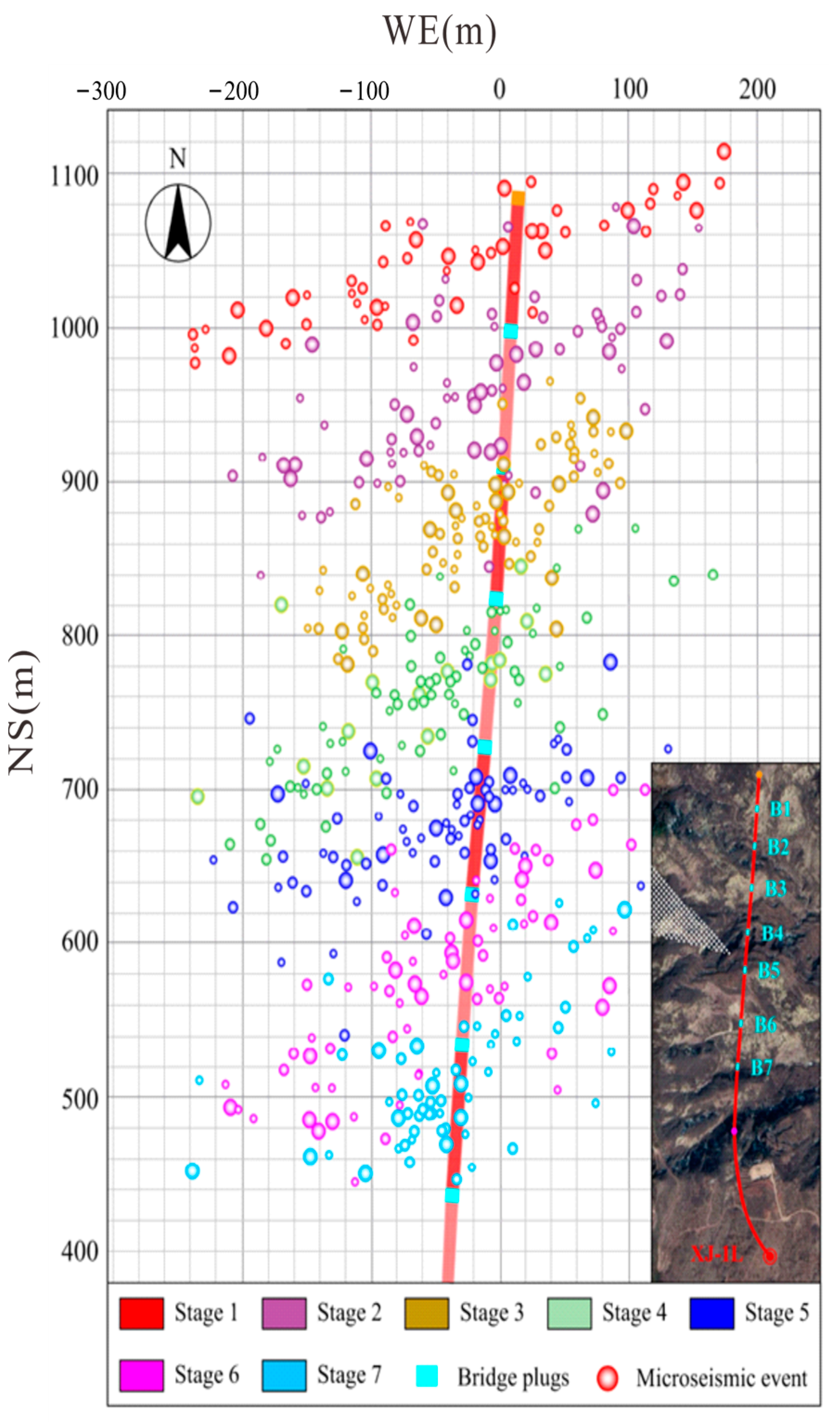

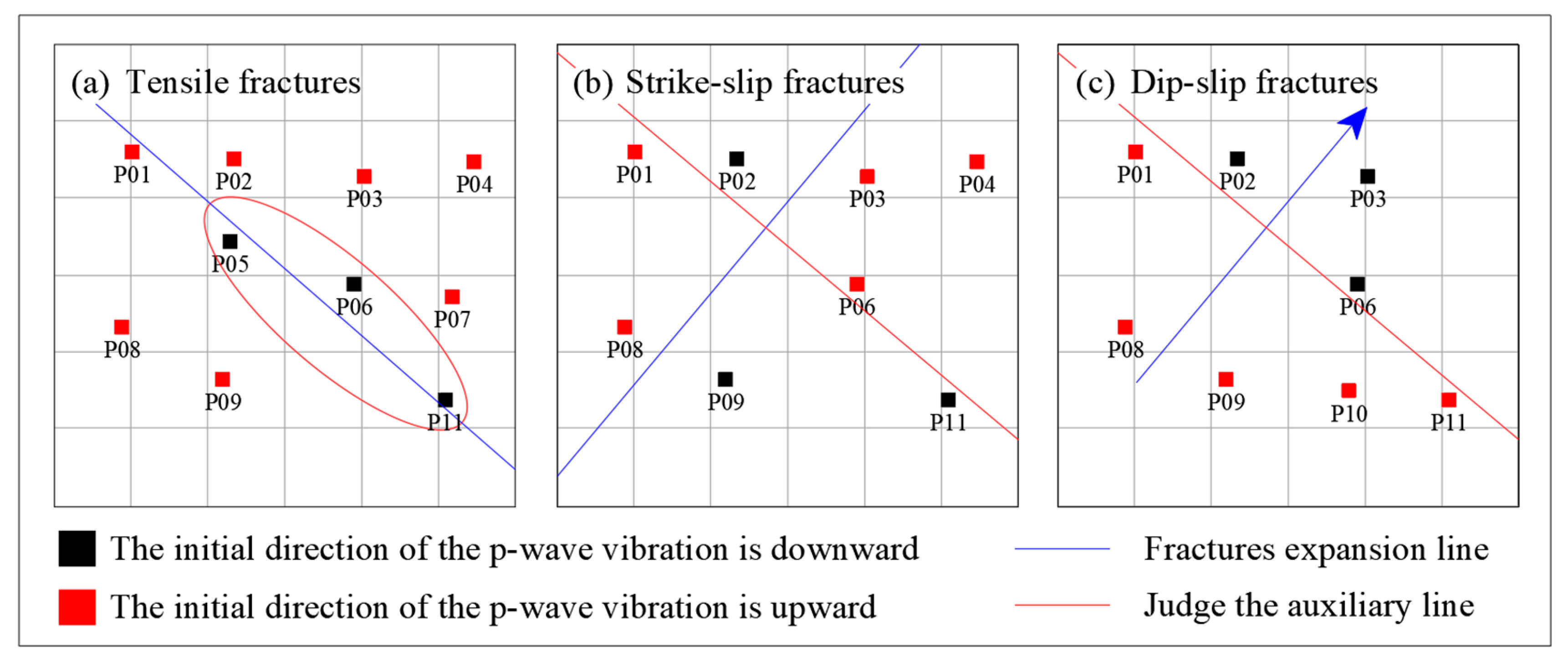
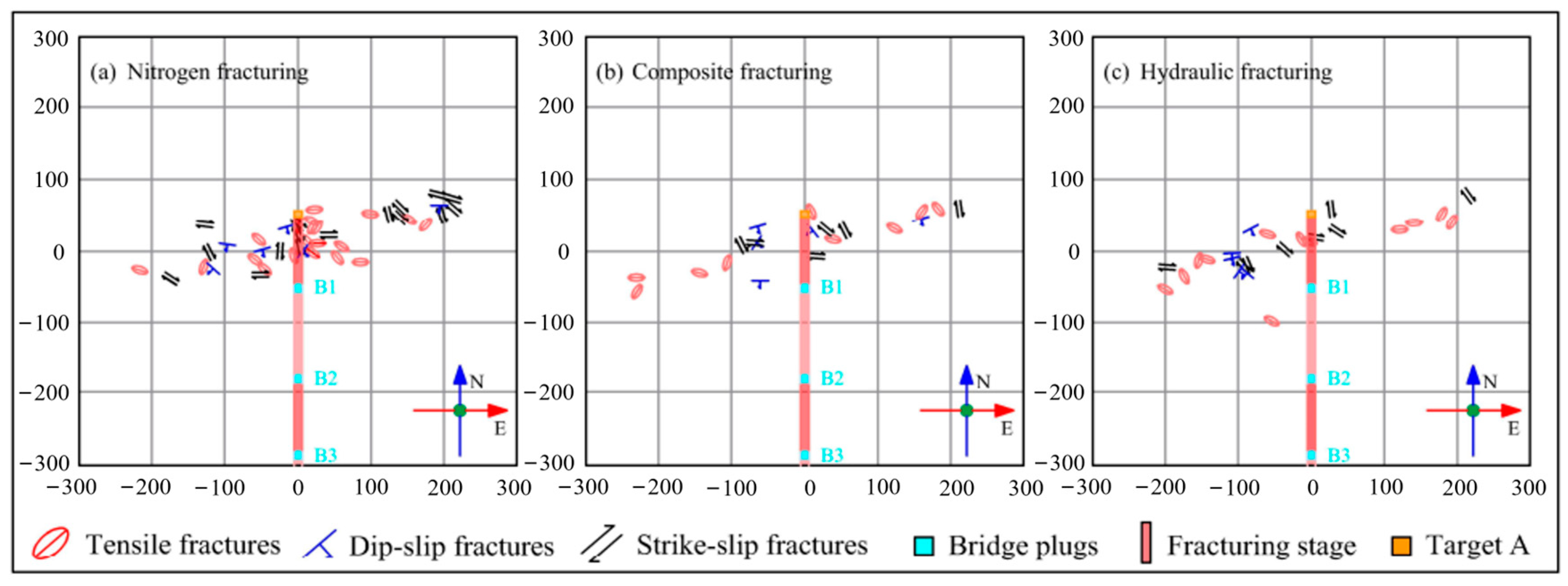
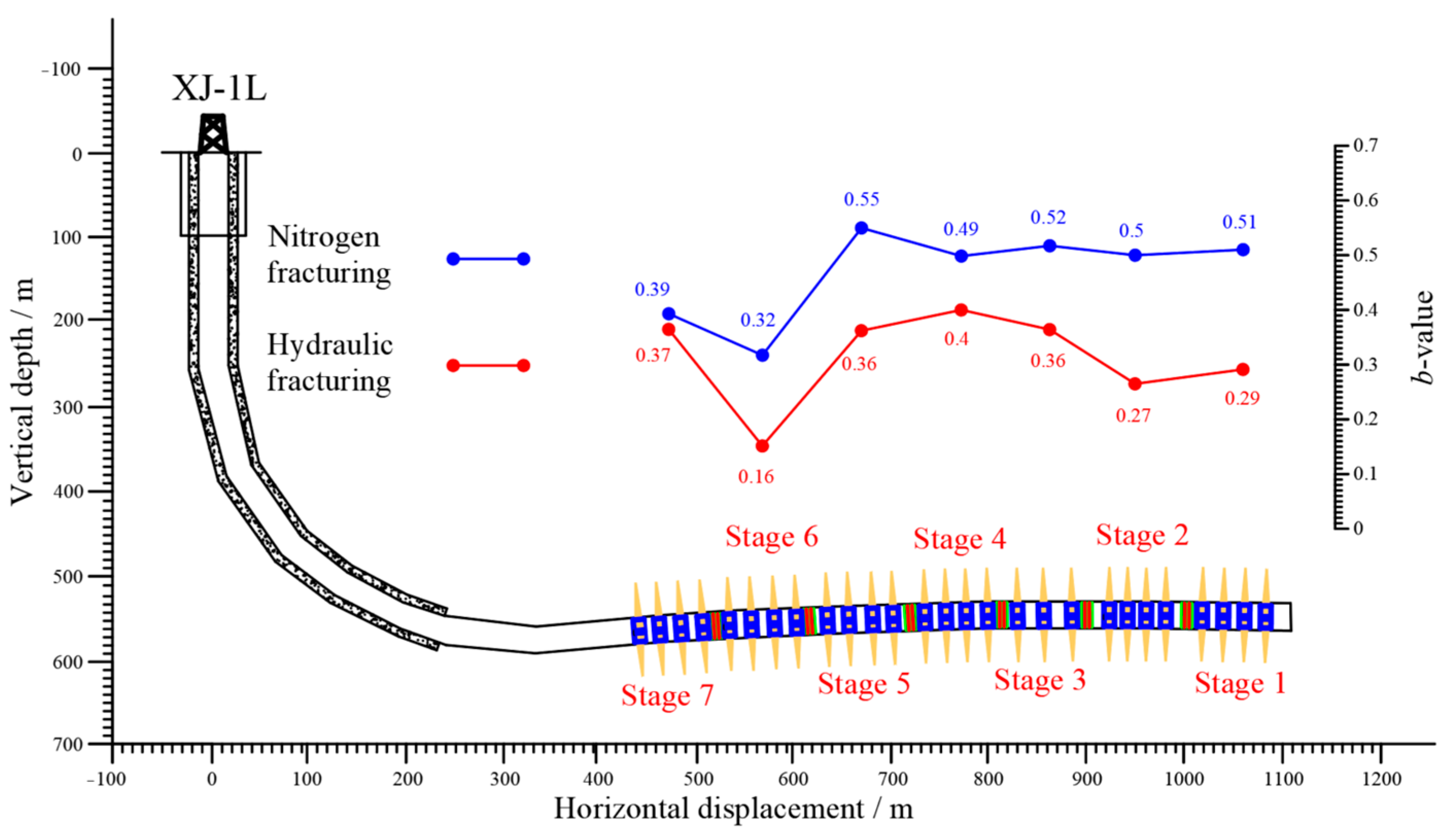
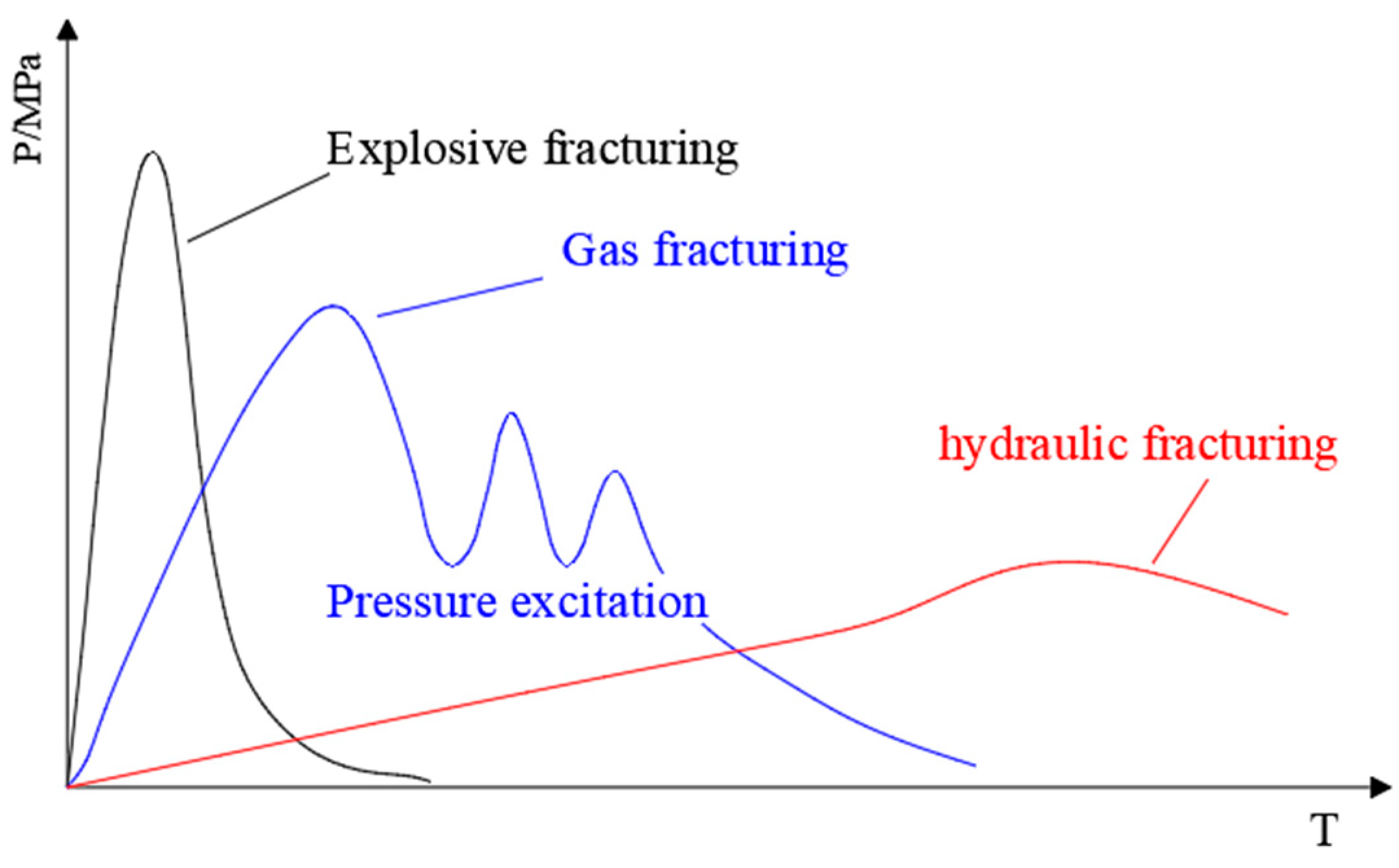


| Fracturing Type | Length/m | Cluster Number | Spacing/m | Bridge Plug Position/m | ||
|---|---|---|---|---|---|---|
| Stage 1 | 1435–1521 | 86 | 4 | / | / | / |
| Stage 2 | 1346–1435 | 89 | 4 | 1414–1451 | 37 | 1435 |
| Stage 3 | 1260–1346 | 86 | 3 | 1328–1361 | 33 | 1346 |
| Stage 4 | 1163–1260 | 97 | 4 | 1239–1281 | 42 | 1260 |
| Stage 5 | 1068–1163 | 95 | 4 | 1149–1180 | 31 | 1163 |
| Stage 6 | 969–1068 | 99 | 4 | 1052–1083 | 31 | 1068 |
| Stage 7 | 870–969 | 99 | 4 | 948–984 | 36 | 969 |
| Fracturing Type | Stage 1 | Stage 2 | Stage 3 | Stage 4 | Stage 5 | Stage 6 | Stage 7 |
|---|---|---|---|---|---|---|---|
| NF (min) | 89 | 75 | 89 | 89 | 91 | 85 | 87 |
| CF (min) | 49 | 62 | 48 | 56 | 63 | 45 | 48 |
| HF (min) | 49 | 45 | 55 | 39 | 40 | 46 | 36 |
| Fracturing Stage | Stage 1 | Stage 2 | Stage 3 | Stage 4 | Stage 5 | Stage 6 | Stage 7 |
|---|---|---|---|---|---|---|---|
| NF | 46 | 72 | 93 | 94 | 86 | 67 | 67 |
| CF | 26 | 70 | 56 | 66 | 68 | 50 | 47 |
| HF | 28 | 38 | 66 | 49 | 51 | 37 | 40 |
| Total | 100 | 180 | 215 | 209 | 205 | 154 | 154 |
| Fracturing Stage | Stage 1 | Stage 2 | Stage 3 | Stage 4 | Stage 5 | Stage 6 | Stage 7 |
|---|---|---|---|---|---|---|---|
| NF | 4.08 | 1.32 | 2.21 | 1.82 | 1.46 | 1.51 | 1.52 |
| HF | 5.12 | 2.28 | 2.28 | 1.98 | 1.69 | 1.52 | 1.57 |
| Fracturing Section | Fracturing Stage | Fractures | Tensile Fracture | Dip-Slip Fracture | Strike-Slip Fracture | |||
|---|---|---|---|---|---|---|---|---|
| Stage 1 | NF | 46 | 17 | 37.0% | 5 | 10.9% | 24 | 52.1% |
| CF | 26 | 9 | 34.6% | 4 | 15.4% | 13 | 50.0% | |
| HF | 28 | 10 | 35.7% | 7 | 25.0% | 11 | 39.3% | |
| Stage 2 | NF | 72 | 26 | 36.1% | 13 | 18.1% | 33 | 45.8% |
| CF | 70 | 12 | 17.1% | 20 | 28.6% | 38 | 54.3% | |
| HF | 38 | 13 | 34.2% | 7 | 18.4% | 18 | 47.4% | |
| Stage 3 | NF | 93 | 42 | 45.2% | 13 | 14.0% | 38 | 40.9% |
| CF | 56 | 21 | 37.5% | 3 | 5.4% | 32 | 57.1% | |
| HF | 66 | 24 | 36.4% | 5 | 7.6% | 37 | 56.1% | |
| Stage 4 | NF | 94 | 28 | 29.8% | 18 | 19.1% | 51 | 54.3% |
| CF | 66 | 19 | 28.8% | 12 | 18.2% | 35 | 53.0% | |
| HF | 49 | 11 | 22.4% | 8 | 16.3% | 30 | 61.2% | |
| Stage 5 | NF | 86 | 32 | 37.2% | 13 | 15.1% | 41 | 47.7% |
| CF | 68 | 21 | 30.9% | 17 | 25.0% | 30 | 44.1% | |
| HF | 51 | 11 | 21.6% | 10 | 19.6% | 30 | 58.8% | |
| Stage 6 | NF | 67 | 15 | 22.4% | 16 | 23.9% | 36 | 53.7% |
| CF | 50 | 19 | 38.0% | 4 | 8.0% | 27 | 54.0% | |
| HF | 37 | 8 | 21.6% | 6 | 16.2% | 23 | 62.2% | |
| Stage7 | NF | 67 | 18 | 26.9% | 10 | 14.9% | 39 | 58.2% |
| CF | 47 | 21 | 44.7% | 6 | 12.8% | 20 | 42.6% | |
| HF | 40 | 16 | 40.0% | 1 | 2.5% | 23 | 57.5% | |
| Fracturing Stage | Stage 1 | Stage 2 | Stage 3 | Stage 4 | Stage 5 | Stage 6 | Stage 7 |
|---|---|---|---|---|---|---|---|
| NF | 0.51 | 0.5 | 0.52 | 0.49 | 0.55 | 0.32 | 0.39 |
| R (variance) | 0.967 | 0.911 | 0.874 | 0.891 | 0.86 | 0.927 | 0.909 |
| HF | 0.29 | 0.27 | 0.36 | 0.4 | 0.36 | 0.16 | 0.37 |
| R (variance) | 0.806 | 0.816 | 0.854 | 0.902 | 0.907 | 0.822 | 0.843 |
| Fracturing Type | Stage 1 | Stage 2 | Stage 3 | Stage 4 | Stage 5 | Stage 6 | Stage 7 |
|---|---|---|---|---|---|---|---|
| NF | 0.099 | 0.046 | 0.178 | 0.043 | 0.037 | 0.127 | 0.101 |
| HF | 0.068 | 0.025 | 0.129 | 0.013 | 0.015 | 0.099 | 0.071 |
Disclaimer/Publisher’s Note: The statements, opinions and data contained in all publications are solely those of the individual author(s) and contributor(s) and not of MDPI and/or the editor(s). MDPI and/or the editor(s) disclaim responsibility for any injury to people or property resulting from any ideas, methods, instructions or products referred to in the content. |
© 2024 by the authors. Licensee MDPI, Basel, Switzerland. This article is an open access article distributed under the terms and conditions of the Creative Commons Attribution (CC BY) license (https://creativecommons.org/licenses/by/4.0/).
Share and Cite
Wang, M.; Tian, L.; Wu, J.; Cao, Y.; Wang, L.; Shi, B.; Sun, M.; Liu, S.; Hu, Y. Fracture Properties of Nitrogen–Slick Water Composite Fracturing in Coal Reservoir. Processes 2024, 12, 1949. https://doi.org/10.3390/pr12091949
Wang M, Tian L, Wu J, Cao Y, Wang L, Shi B, Sun M, Liu S, Hu Y. Fracture Properties of Nitrogen–Slick Water Composite Fracturing in Coal Reservoir. Processes. 2024; 12(9):1949. https://doi.org/10.3390/pr12091949
Chicago/Turabian StyleWang, Menglong, Lin Tian, Jinghao Wu, Yunxing Cao, Li Wang, Bin Shi, Mingyue Sun, Shimin Liu, and Yunbing Hu. 2024. "Fracture Properties of Nitrogen–Slick Water Composite Fracturing in Coal Reservoir" Processes 12, no. 9: 1949. https://doi.org/10.3390/pr12091949
APA StyleWang, M., Tian, L., Wu, J., Cao, Y., Wang, L., Shi, B., Sun, M., Liu, S., & Hu, Y. (2024). Fracture Properties of Nitrogen–Slick Water Composite Fracturing in Coal Reservoir. Processes, 12(9), 1949. https://doi.org/10.3390/pr12091949






